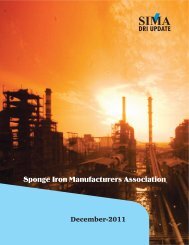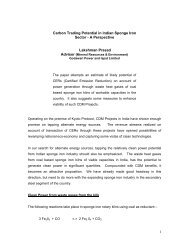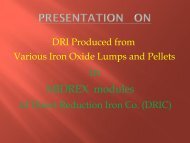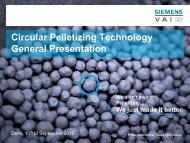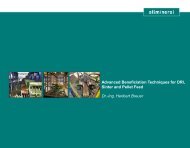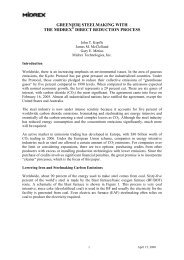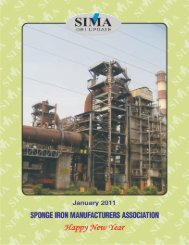You also want an ePaper? Increase the reach of your titles
YUMPU automatically turns print PDFs into web optimized ePapers that Google loves.
SULFUR CONTROL IN THE DRI PRODUCT<br />
FROM IRON OXIDE REDUCING KILNS<br />
V. SRINIVAS, SR. ENGINEER, MID INDIA ENGINEERING LTD.<br />
One of the most important problems on the chemical<br />
content of the DRI product resulting from the direct<br />
reduction of ores is the level of sulfur in the DRI<br />
since severe process difficulties are posed to<br />
processors using such DRI for the making of steel<br />
by even small amounts of sulfur in their feed stock.<br />
Accordingly, a strict upper limit of 0.03% sulfur by<br />
weight in the DRI product should be achieved and<br />
preferably even lower sulfur levels would be<br />
desirable. To this end, a conventional practice in<br />
the process for directly reducing iron ores in a rotary<br />
kiln using coal fed at both the ore feed and discharge<br />
ends, is to add a sulfur control agent, such as<br />
limestone or dolomite, to the charge at the feed end<br />
of the kiln.<br />
The important factors in the process affecting the<br />
sulfur levels in the DRI and steps and means for<br />
properly controlling these factors<br />
(1) high temperatures in the kiln bed;<br />
(2) Low level of char in the kiln discharge materials;<br />
(3) Inadequate control of limestone or dolomite<br />
feeding;<br />
(4) Recycling of used limestone or dolomite in the<br />
char from the kiln discharge that is returned to<br />
the kiln;<br />
(5) The fines content of the ore feed;<br />
(6) the sulfur level in the feed coals;<br />
(7) the sulfur level in the ore feed;<br />
(8) inadequate control of the feed end bed and gas<br />
temperature profiles to promote oxidation of the<br />
sulfur in the feed end coal; and<br />
(9) contamination of the product pellets by char,<br />
grease or etc.<br />
(1) Kiln Bed Temperatures<br />
Mainly sulfur absorption problems occur in the bed<br />
over about the last one-third of the kiln length, and<br />
more specifically in the region where high residence<br />
times and the highest bed temperature.<br />
(2) Char Level in the Kiln Discharge Materials<br />
Closely regulating the ore, coal, and char feeding<br />
to the kiln to maintain the specified range of fixed<br />
carbon (5-15%) by weight in the total discharge<br />
materials from the discharge end of the kiln,<br />
contributes significantly to maintaining low levels of<br />
sulfur in the DRI.<br />
(3) Sulfur Control Agent Feeding<br />
Limestone or dolomite is added to the kiln feed as<br />
the control agent for sulfur removal, generally in the<br />
range from 1% to 5 % by weight of ore feed further<br />
important consideration is that the sizing of the<br />
particles of limestone or dolomite feed must be<br />
closely controlled to achieve incorporation of the<br />
control agent into the bed when feeding it with the<br />
ore through the feed end of the kiln. If the particles<br />
are too small, substantial losses of the control agent<br />
may occur in the exhaust gases passing out of the<br />
feed end, but, on the other hand, large limestone<br />
particles cannot effectively absorb the sulfur.<br />
Therefore, the control agent particles should<br />
preferably be of an intermediate size with respect to<br />
the other feeds, that is, such a size as 1-4 mm.<br />
(4) Recycling of Used Control Agent in the Return<br />
Char<br />
Limestone or dolomite that has passed through the<br />
kiln may have absorbed a relatively great amount of<br />
sulfur so that if it is re-fed to the kiln in the recycle<br />
char system, it can act as a sulfur source, thus slowly<br />
increasing the total sulfur load to the kiln.<br />
(5) Ore Feed Screening<br />
Analysis of the sponge iron or DRI particles has<br />
shown that any sulfur incorporated into the product<br />
is deposited on, or in close proximity to, the particle<br />
surface. Thus, to minimize sulfur content, the surface<br />
MAY-<strong>2007</strong>/31



